The Wine of the Bolognese Templars: a case study
By Giampiero Bagni
If you travel extensively in Italy, it is impossible to avoid Bologna. Due to its geographical position, (Fig. 1) the city is, and always has been, a major crossroads, connecting key ports, cities, and travel routes. The University of Bologna is situated right in the middle of this junction and is the oldest scholarly institutions in the western world – it was founded in 1088.
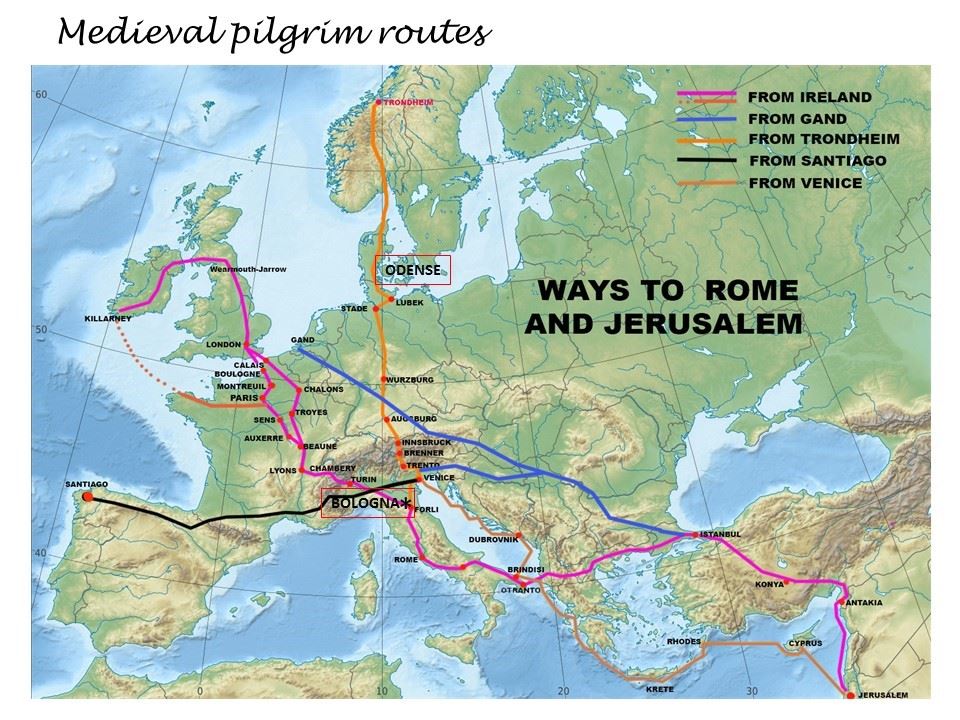 Fig.1
Fig.1
Because of the city’s significant international exchange and intellectual prowess, its Templar Commandery, likely established around 1150, was extremely influential. Its substantial local wine production helped fund the Templar brothers in the Holy Land. However, this Commandery has received very little scholarly attention – until now.
This is part of a first specific study regarding the production of wine within the economy of the Bologna Templar Commandery. The work draws on information from archival sources, archaeological and palynological samples and so on. Because this location is understudied, it was necessary to reconstruct every aspect of the Commandery, as far back as its establishment. I set up a steering committee of scholars and local experts on military orders to develop a multidisciplinary approach to this subject. The members include archaeologists, archivists, anthropologists, art historians, biologists, palynologists and other experts.
Until very recently, it was difficult to pinpoint evidence for the exact date of the establishment of the Bologna Templar commandery. Only recently combining the archeological results and wide archival research it was possible to affirm that the entire life of the Templar Commandery in Bologna can now be dated to between 1150 and 1313, when the Commandery passed to the Hospitallers. The house was situated along the Roman Via Emilia (Fig. 2), 400 meters eastward and outside of Bologna’s Eleventh-century walls.
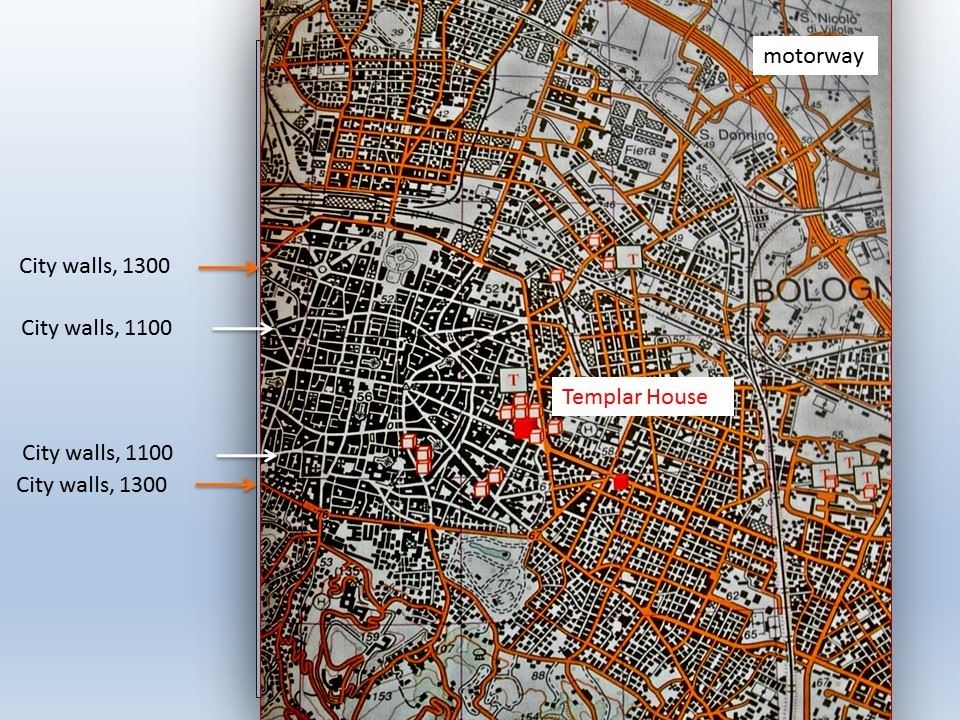 Fig.2
Fig.2
The possible foundation around 1150 is also supported by the results of the 2015-16 archaeological excavation of the Commandery, including the stratigraphical (Fig.3) dating of retrieved building materials and palynological assays of plant residues conducted at the beginning of 2016.
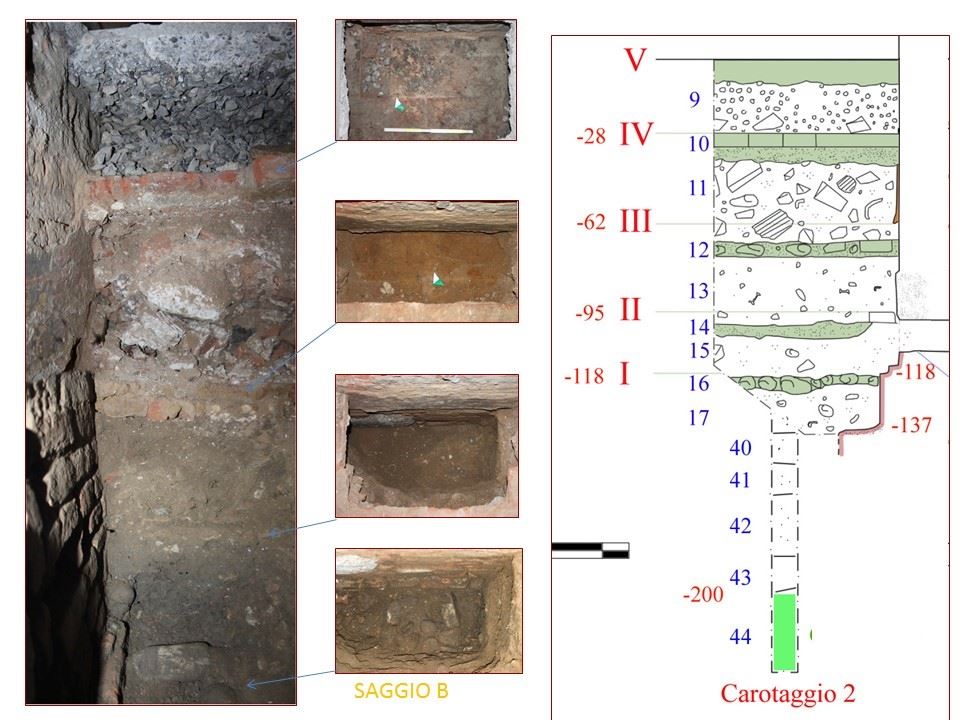 Fig.3
Fig.3
My extensive research in local Italian archives, particularly in the Archbishopric archive of Ravenna, turned up coeval documents related to the local trial and the properties of the Bolognese Templars. These documents include the Inventory of Templar properties (Fig.4) prepared by the Inquisition in March 1309 and then used later the same year by Archbishop Rinaldo of Ravenna, who organized the Templar local trials.
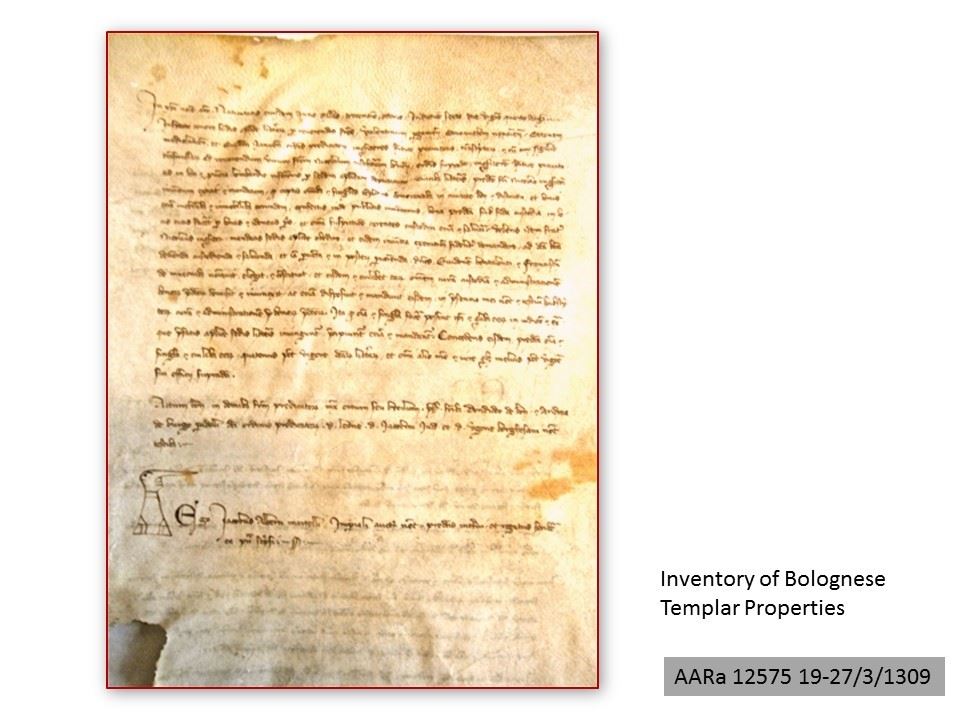 Fig. 4
Fig. 4
This detailed inventory lists all the urban (Fig. 2), mainly houses, and suburban (Fig.5) properties held by the Templars, indicating their borders, neighbors and the type of property: house, crop field, vineyard and so on. The acreage of these estates was measured in tornature, a unit equivalent to 2,080 square meters. Most of the Templar holdings in the city and environs were used to grow cereal crops. The rest included vineyards, vegetables and pasture land. Since the front and back of the first sheet of the Ravenna inventory are defaced, and the units of land are not recorded for all holdings, the total size of the Bologna commandery’s estates is approximate, yet substantial, at over 83 hectares.
According to these records, the Templar vineyards were located in the eastern plain near the present-day town of Marano di Castenaso (Fig.5), where there is still a marker vineyard of the Albana variety.
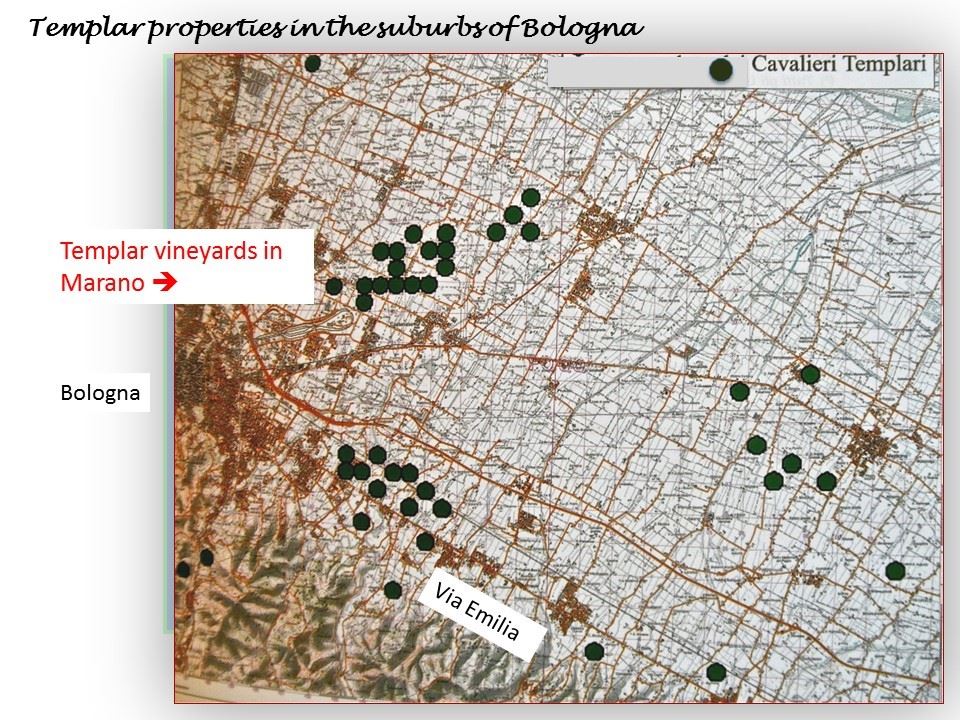 Fig.5
Fig.5
Beyond their landholdings, the 1309 Inventory of Templar Properties lists the goods stored in the warehouse of the Commandery’s still extant Knights’ Hall (Fig.6), where we conducted the excavation.
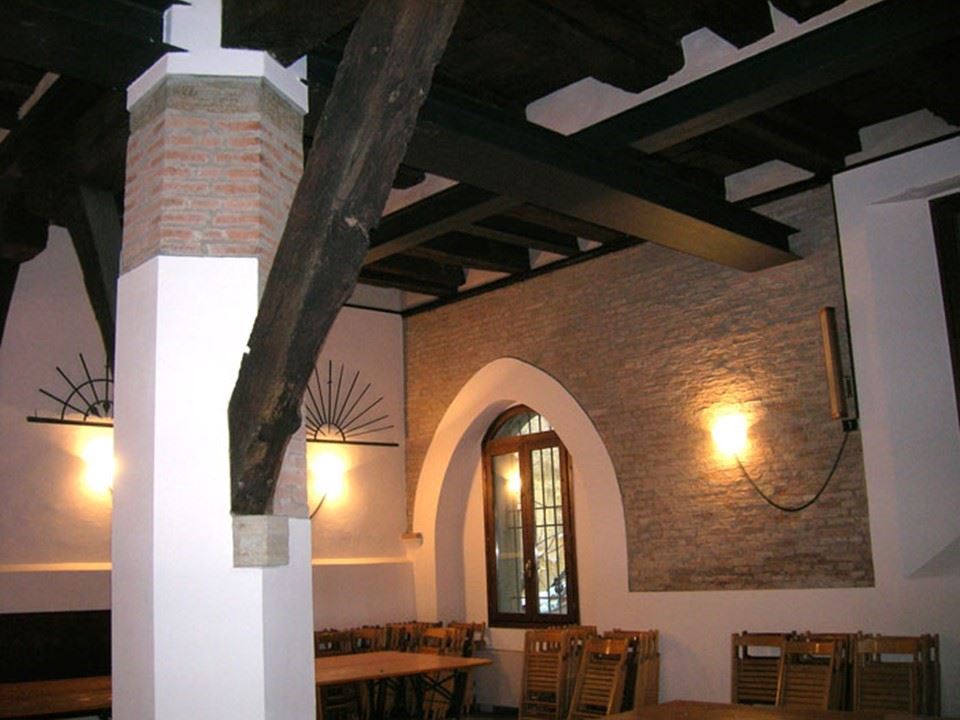 Fig.6
Fig.6
The inventory claims the Templars had 25,000 liters of wine in large casks stored there. The wine was likely bottled from harvests within at least five of the preceding years. The 3D reconstruction of the medieval Commandery developed from this research, in particular of the wine storage area, elaborates on this fact (Fig.7).
 Fig.7
Fig.7
Although the Templar Order possessed vineyards across Western Christendom, the research that is perhaps most comparable to the situation in Bologna is Dominic Selwood’s study of the Sant ’Eulalia commandery in southern France. For example, Selwood notes that Sant ’Eulalia’s stores held some 20,000 liters of wine from probably 15 hectares of land. This figure is only 4,000 liters less than the quantity listed for the Bologna commandery. It appears to underscore that, as in Bologna, the wine was most likely sold locally and the revenues (Responsiones) were allocated to support the Order’s efforts in the Holy Land. Given wine’s bulk weight and its impaired shelf life during overseas transit, it seems most plausible to assume that it was sold in local markets and the profits were sent to the Eastern Brothers. There was some wine transported between Commanderies in Europe, such as from La Rochelle, France to England, but that was mainly for Templar use. My recent research on the Order’s vineyards in Bologna expanded the economic analysis by seeking, firstly, the financial value of the wine produced by the Bolognese Templars and, secondly, identifying the wine grape cultivar via laboratory assays.
Bologna had been a wine grape district in the Roman Empire and it resumed production in the early medieval period, following the collapse of the Empire of the West after 476. By the turn of the Eleventh Century, most of the vineyards lay within the city’s three-mile urban-suburban boundary belt. Winegrape cultivation spread further during the Thirteenth Century, driven presumably by population increases, which included students attending the University. The spread of vineyard acreage to the eastern reaches of the city is noteworthy, as it was within these suburbs that the Bologna Templar commandery would establish holdings. With a population estimated at 50,000 inhabitants by the beginning of the Thirteenth Century, the city’s wine cultivation grew in step with demand and new vineyards were planted in the lowland areas. There were two kinds of plantings: full-field vineyards and individual rows of vines serving as boundary markers in fields of grain and other crops. The grape cultivars grown in local vineyards were recorded by medieval jurist Pier de ’Crescenzi in his writings on agriculture. He notes that there were some forty cultivars of both white and red grapes. The whites included Sclava, Albana, Garganica, and Malixia, and the reds Grilla, Gramesta and Lambrusca - some of these varietals are still grown today.
By tradition and codification in municipal statutes, the grapes were pressed to must (the freshly pressed juice including skins and stems) on site and then delivered in tuns of 785 liters each, called castellata, to the owner’s winery. Any surplus wine was delivered for sale to the wine market, a central square near what is now the enormous Church of St. Petronius. Transport, unloading and measuring of the wine were done by Brentatori, authorized intra-mural liverymen and wine sellers. Their name was derived from the 39-liter containers in which they transported wine.
Beyond the wine trade, it is crucial to note that an imperial charter of 1191 granted Bologna the right to coin money. The city’s currency consisted of the silver soldo of bolognini, equal to 1,41 grams of silver. One Bolognese Lira - similar to the generally used Imperial Lira - had an exchange rate of 20 soldi of bolognini, the equivalent of 28.2 grams of silver. This initial appraisal relies on the economic models Paolo Malanima applies in his Economia Italiana in 2002, combined with a set of archival documents. Malanima’s analyses employ a series of databases and the value of the Florentine florin for comparing the price of goods such as grain, wine, olive oil, meat and textiles in the economies of medieval North Italian cities.
Local historian Antonio Ivan Pini in 1998 estimates that by the mid-Thirteenth Century the average value of a full-field vineyard in Bologna was 30 lire per 2,000 square metres (approx. $145) and the value of marker vines was 10 lire (approx. $48). So, the approximate currency equivalents are: 1 lira Bolognese corresponds to 20 soldi of Bolognini, 1 Gold Florentine florin corresponds to 24 Bolognese soldi. These numbers also adhere to the model proposed by Peter Spufford in his Handbook of Medieval Exchange, published by the Royal Historical Society in 1986.
Here the local archives are invaluable yet again: the Bologna Commune set the price of wine in 1256 at approximately 1 soldo per 79 litres. That wine production was becoming extensive during the mid-late Thirteenth Century is shown by a tariff the Commune levied on imported wine in 1288. On the other hand, the duty it levied on exporting wine was minimal. The city’s average wine consumption in the Middle Ages was 200 liters per capita per year, as compared to 100 liters per capita in 1970. The Inquisition’s inventory indicates that the Templars possessed at least 4 hectares of full-field vineyards, 6% of its assets, mostly in the lowland districts southeast of the city. The value of this land would have been approximately 600 Bolognese lire (12,000 soldi).
My inventory analysis found that there were also about 13.6 hectares of marker vineyards in roughly the same area, valued at roughly 700 Bolognese lire. Given the lacuna of the inventory because of the defaced sheets, and the fact that several plots contiguous to those mentioned do not list crops, it is estimated that the total wine grape acreage may have been 20 hectares. This would mean that wine grape acreage accounted for approximately 25% of Templar property assets (83 hectares in all), well in excess of the Bolognese wine holdings of the other ecclesiastical orders. In other words, the overall value of Templar vineyards would have come to some 1,500 Bolognese lire, some 30,000 soldi, making it clear that the Bolognese Templars produced a considerable amount of wine. To better comprehend these figures, it helps to understand some basic costs at the time. In 1309 Archbishop Rinaldo stated that each of the Templar brothers remanded for trial in his jurisdiction was to receive a yearly allotment of around 500 liters of grain and good wine, 4 liras of Bolognini for clothes and shoes, and 5 soldi of bolognini per day for all the other necessities. For similar properties of the nearby St. Proculus convent, Pini estimates that the average winegrape yield per hectare was 200 litres or about 4,000 litres for all of its vineyards per year. The Templar Knights’ Hall held 25,000 liters, six-fold more than the average yearly production.
Further investigation of the Ravenna Archbishopric archive has uncovered a receipt that Archbishop Rinaldo (Fig. 8) issued on 13 of October 1309 for more than 25,000 litres of wine from the Bologna commandery’s stores. Its value was calculated by the Brentatori at some 3 soldi per corba (79 litres), or three-fold the usual price set by the Commune.
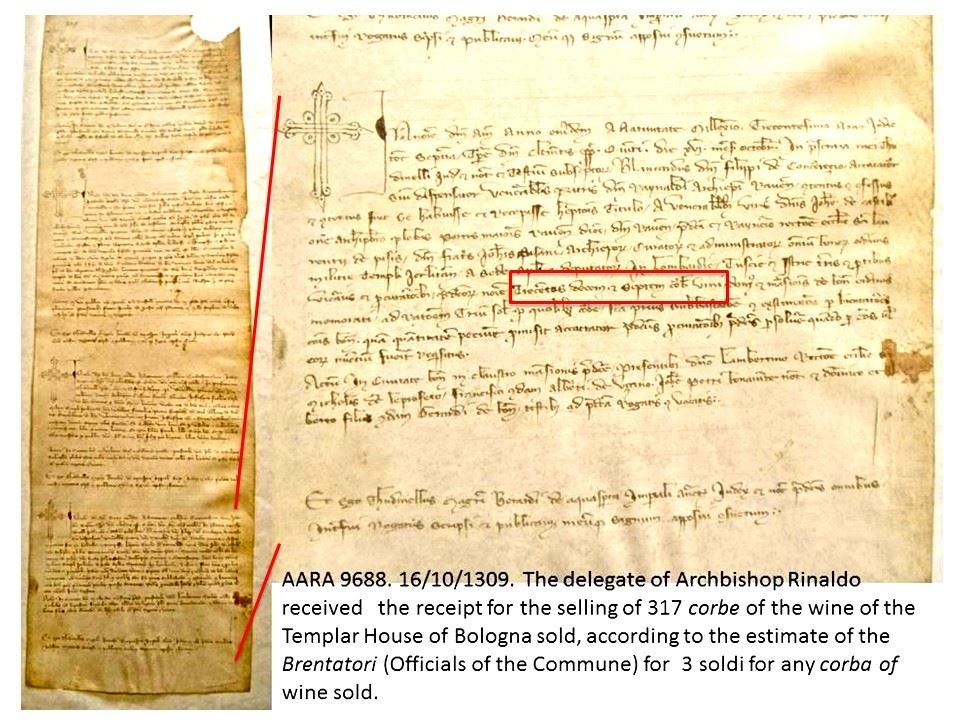 Fig. 8
Fig. 8
That could indicate that the wine was from a cultivar of superior quality - our laboratory analysis will attempt to verify whether or not this is true. If it is true, the value of these stores would have been on the order of 950 soldi of bolognini. No matter what, it is clear that the Bologna Commandery prospered from producing and trading wine, especially when compared to other local monasteries or the St. Eulalia Templar Commandery.
What we do not yet know is the exact kind of wine the Templars cultivated. The other target of this research is to identify the wine grape cultivar via laboratory assays of the pollen obtained in the cores taken during the archaeological work. The cored pollen samples of grapevines found in the site surveys are stratigraphically coeval with the Bologna commandery, from the mid-Thirteenth Century. From the stratigraphy and the related cores (Fig.9), we extracted many samples containing grape pollen together with others.
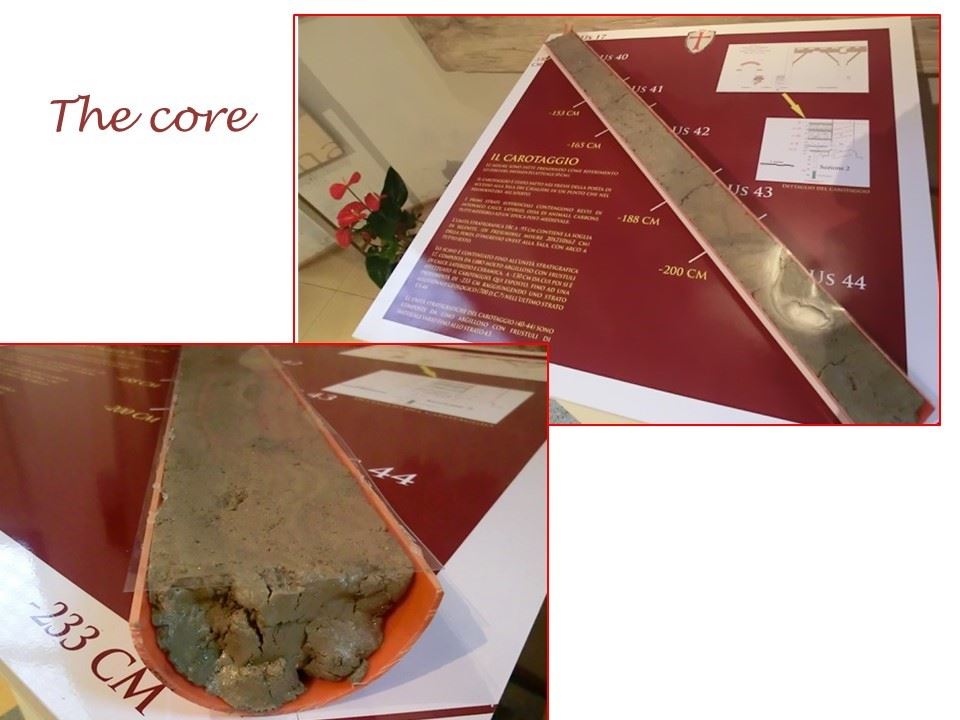 Fig.9
Fig.9
These samples made it possible to isolate pollen grains of vines in relatively good condition (Fig. 10). These samples are currently being tested to determine the varieties cultivated.
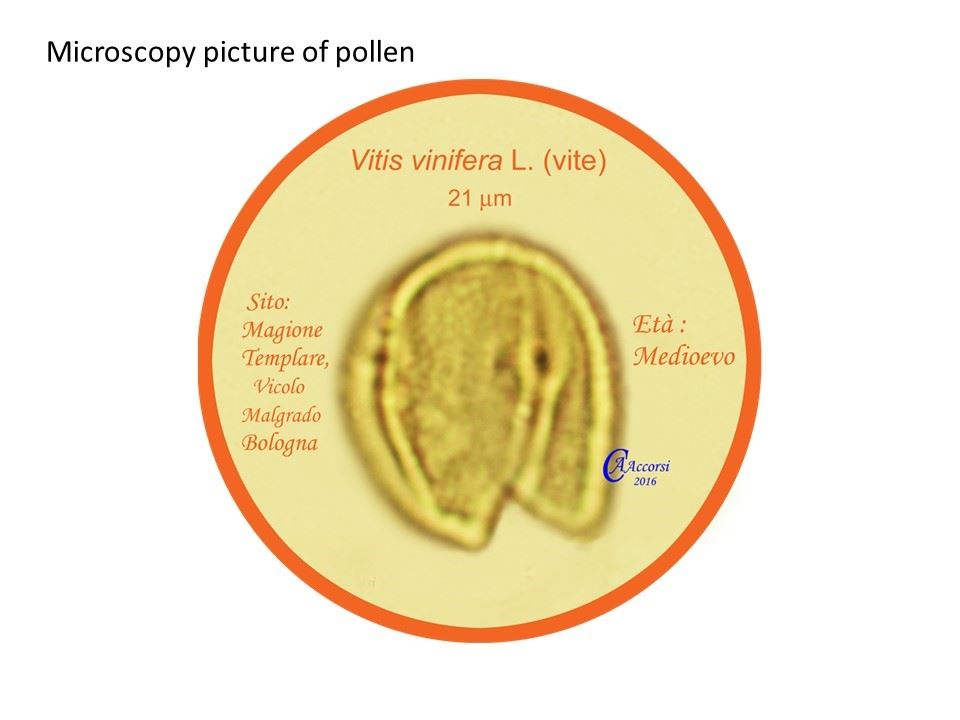 Fig.10
Fig.10
This testing could enable the reconstruction of a vineyard similar in all respects to that grown by the Bologna Templars. If successful, it would be the first time a laboratory-based effort of this kind has been attempted. The next step has been to obtain the DNA from a single pollen grain extracted, thanks to collaboration with Prof. Luca Dondini of the laboratory of the Dipartimento di Scienze e Tecnologie Agro-Alimentari at the University of Bologna, who amplified massively the material using an adapted specific amplification kit. The amount of DNA extracted from the pollen sample was so sufficient to match the DNA using the Italian Vitis Database, even if the DNA pollen was originally so ancient and degradated. That Database has the grapevine data sequenced by 2007, which enabled us to match sequences with more than an 80% accuracy rate. A new technique called Next Generation Sequencing costs less than previous techniques and has a very high efficiency rate. The result of the comparation between the pollen obtained in the archaeological excavation and the DNA of the different cultivars give the results that the Templar Wine was Albana. A grapevine callus developed by the University of Trento (Fig.11) is a great example of what can be achieved.
 Fig.11
Fig.11
We hope that this technique will lead us to obtain a similar callus, produced using the DNA of the “Templar pollen”. From that finding, a plant could be developed (Fig.12)
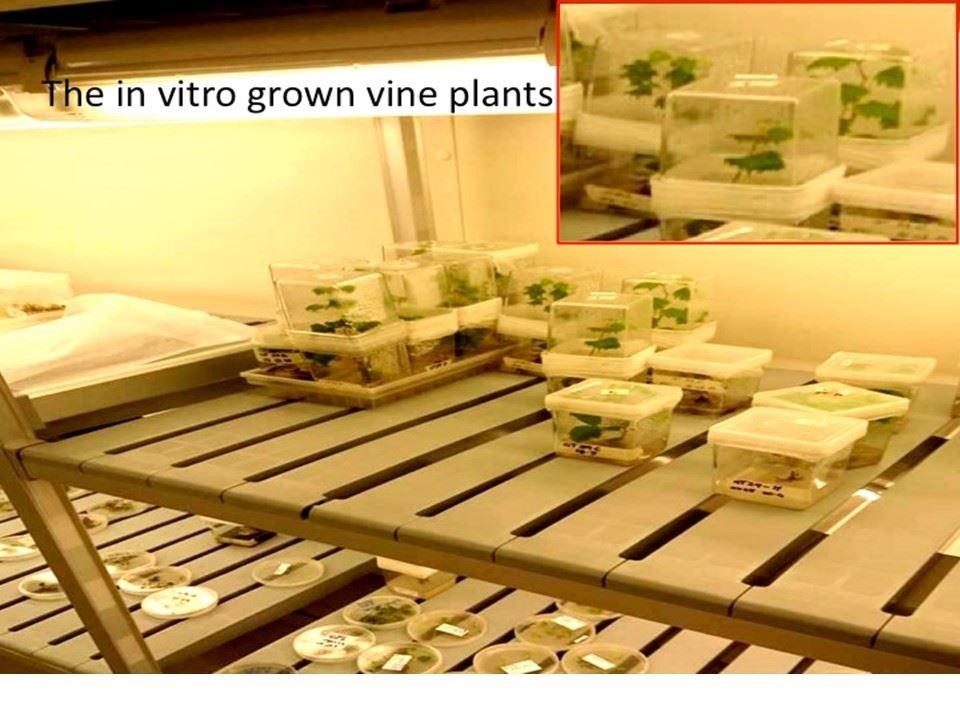 Fig.12
Fig.12
This laboratory-grown plant could then be grafted onto a historical cultivar of Albana still growing in a Marano vineyard, an area surrounding Bologna, that was once a property of the Templars as mentioned in the Inventory (Fig.13).
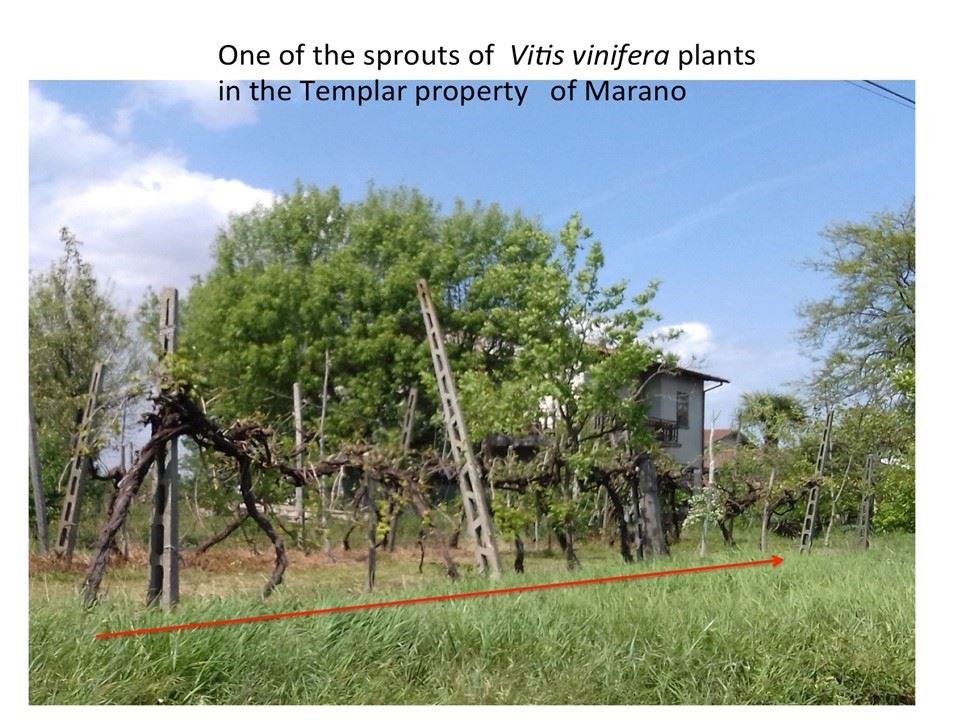 Fig.13
Fig.13
The goal is to obtain harvest grapes that are as similar as possible to those that produced the wine contained in the barrels listed in the 1309 inventory of the Templar commandery. If this can be achieved, the resulting wine would be derived from verifiable archival, archaeological and scientific sources on historical Templar wine.